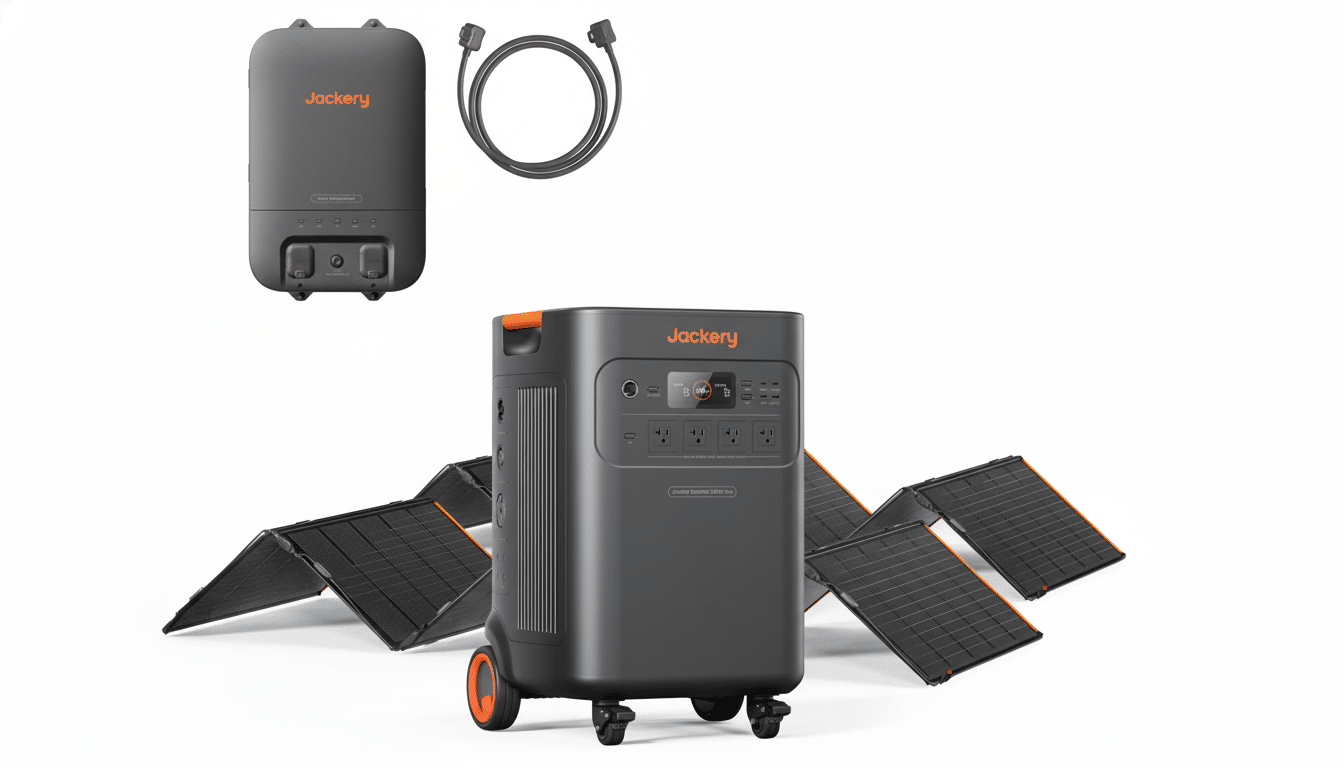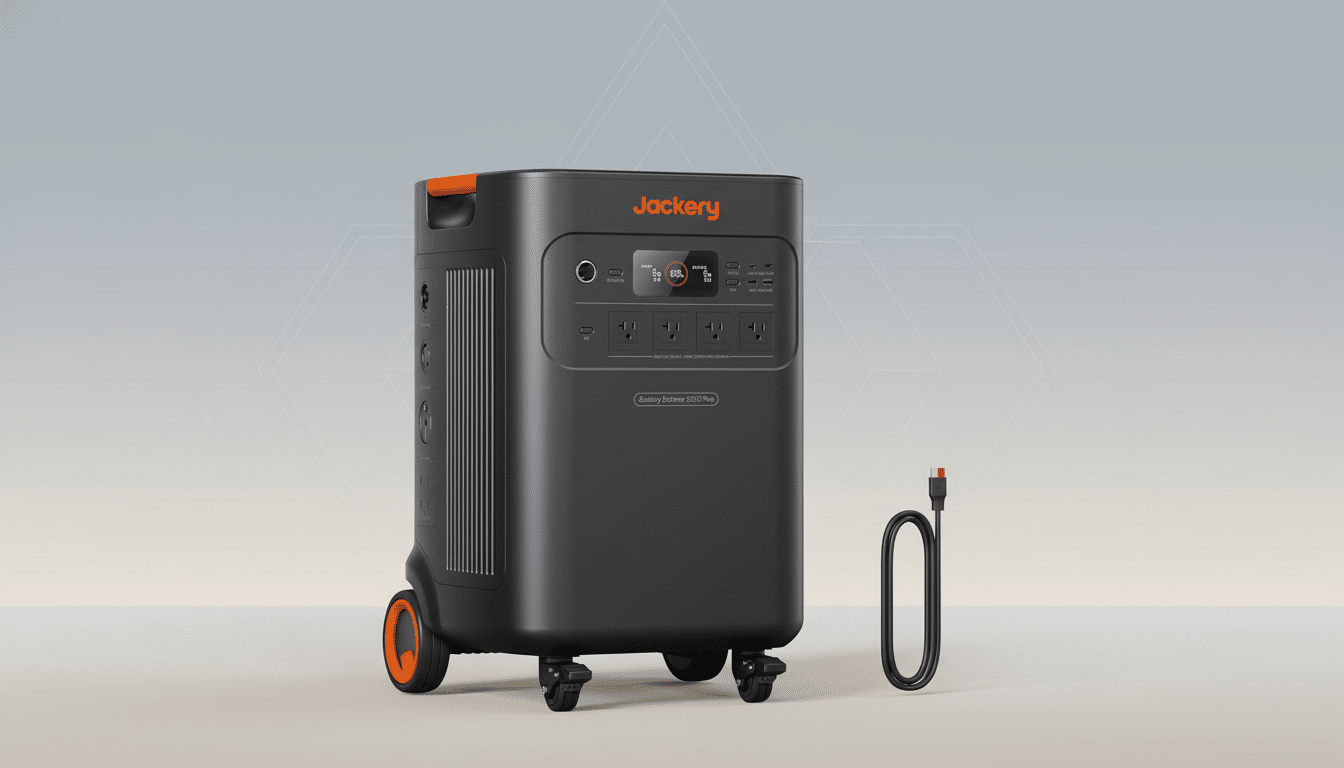The Jackery Solar Generator 5000 Plus is now on sale for $2,998.95 (down from $4,299), saving you an impressive $1,300. For a system that’s capable of backing up whole-home essentials while cooking dinner, running the RV circuits and potentially scaling to something dramatic with added batteries, this deal gets the 5 kWh base kit down toward ~$1.40 per watt-hour, a very aggressive price in today’s portable power land.
Why This Deal Matters for Home Backup and RV Power
Grid outages are becoming more common, and portable power stations have gone from nice-to-have to preparedness essentials. The 5000 Plus isn’t a pocket pack; it’s a high-capacity home backup hub that uses an expandable architecture. Starting at the smallest 5 kWh base unit and scaling up to an enormous 60 kWh, the 5000 Plus can go from weekend camper to multi-day outage insurance.
- Why This Deal Matters for Home Backup and RV Power
- Power and real‑world loads for 120V and 240V use cases
- Battery chemistry and efficiency of the LiFePO4 system
- Solar input and off‑grid strategy for sustained essentials
- Value versus competitors on a dollars‑per‑kWh basis
- Installation and safety notes for home and RV setups
- Who the Jackery 5000 Plus solar generator suits best
- Bottom line: a strong time to buy at this discount level

To put that in numbers, average U.S. residential consumption is about 29 or 30 kWh per day according to the U.S. Energy Information Administration. That’s two days of “average” whole-home usage for a fully completed 60 kWh stack, in other words. Jackery’s “up to 15 days” estimate is doable if you’re powering just the essentials—refrigeration, lights, communications and occasionally running a pump or tool—which are distinctions smart users plan for ahead of time.
Power and real‑world loads for 120V and 240V use cases
The 5000 Plus is capable of up to 7,200W of output and can be doubled in expanded configurations, working with both 120V and 240V. It’s that split-phase capability that opens the door to high-voltage appliances other portable units can’t handle—like well pumps, electric dryers or an RV’s circuit (they often run on a 240V line).
In actual use, that’s enough storage for a full-size fridge’s hum (about 1–2 kWh/day), lights and networking, with room to spare for the intermittent draw of power tools or a sump pump being cycled on and off.
Highlights include the 0 ms UPS mode. The old-fashioned offline UPSs they compete with switch in 8–20 ms, which is going to glitch your sensitive electronics. A zero-transfer switchover keeps desktops, networking gear and home offices steady the instant the grid blinks. Pair that with app-based monitoring and controls—offering things like scheduling charge windows for time-of-use rates—and you have hardware built for your emergencies as well as your, uh, energy management.
Battery chemistry and efficiency of the LiFePO4 system
It is based on lithium iron phosphate (LiFePO4) cells, which are prized for their greater thermal stability and cycle life compared with older chemistries. So, allow around 85–90% system efficiency considering inverter and conversion losses. Translating that into action: a 5 kWh module can provide around 4.3–4.5 kWh of power to your devices. That’s still more than enough for a refrigerator, a modem, a router, several LED lights and phone charging for several days if you work loads just right.
Solar input and off‑grid strategy for sustained essentials
Using MPPT solar charging and with support for high-wattage panels, the 5000 Plus can indeed capture a decent amount of energy away from civilization. The output depends on the size and location of your array. Per a very rough rule of thumb with numbers provided by the National Renewable Energy Laboratory, on average, a 200W portable panel yields around 0.8–1.2 kWh per day of sunshine. Scale that up to four 200W panels and you’re looking at an additional 3–5 kWh per day—a figure sufficient to keep the essentials ticking over indefinitely in bright conditions, especially if you can move large loads (like your washing machine) toward midday when the sun is most powerful.

Value versus competitors on a dollars‑per‑kWh basis
With a base 5 kWh system costing $2,998.95, the per‑kWh price pencils out to about $600/kWh at the discounted rate. For perspective, most high-end portable power stations run between $650 and $900 for a kWh at retail. High-output rivals such as EcoFlow and Bluetti offer good ecosystems with modular batteries and 240V options, but this Jackery pricing is unusually sharp for a unit that can handle split-phase loads, along with deep expansion. If you’re going for dollars per usable watt-hour and you’re not ready to start the discussion of a permanent home battery, this is an ace.
Installation and safety notes for home and RV setups
Though “portable,” this is not a one-person lift—5 kWh on top of a 240V line deserves some kind of critical mass, with good venting and clearances.
If you will be backfeeding home circuits, employ a transfer switch or interlock installed by a professional electrical contractor in accord with National Electrical Code Article 702 for Optional Standby systems. This feature eliminates risky backfeed onto the utility grid and helps keep your warranty valid and support your insurance. Just like any high-capacity system, search for certifications assuring efficacy and make sure your setup can meet load demands.
Who the Jackery 5000 Plus solar generator suits best
Homeowners in blackout‑prone regions, RVers wanting real 240V convenience and small businesses demanding the most from their power protection investment will find that the 5000 Plus has a lot to offer.
Preppers and off-grid cabins can begin with the base discounted unit and incrementally add on. If all you need is a little portable for camping electronics, this is overkill; if you want a quiet, emissions‑free answer to a gas generator that can scale up into big‑time backup power, it hits a sweet spot.
Bottom line: a strong time to buy at this discount level
With $1,300 off, the Jackery Solar Generator 5000 Plus offers big‑system capability and zero‑fuss UPS protection with plenty of room to scale—at a per‑kWh price that’s hard to ignore. Prices and stock can change, but if you’ve been waiting for a portable power platform with whole-home capability, this is an excellent time to buy.

